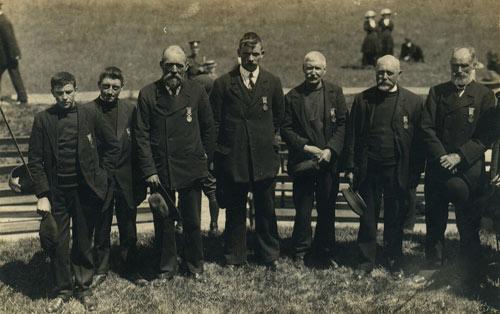Lusitania memorial service remembers Manx rescuers
On 7 May 2014, as part of the Maritime Museum's memorial service to commemorate the 99th anniversary of the sinking of the Lusitania, Roy Baker, Curator of Leece Museum, talked about how a ship from the Isle of Man played a key role in the rescue efforts. Guest blogger Valerie Caine has more details.

Crew of the Wanderer. Photo courtesy of the Leece Museum in Peel.
The sinking of the luxurious liner Lusitania in just eighteen minutes off the Old Head of Kinsale in Ireland in 1915 by a German submarine resulted in the loss of 1,198 lives. One of the first rescue vessels on the scene was a small Manx fishing boat PL11 Wanderer, from Peel on the west coast of the Isle of Man.
It was to be two hours before rescuers heading from the Irish mainland reached the scene, but the crew of the twenty ton lugger, Wanderer, fishing a few miles off Kinsale with 800 mackerel on board, was alerted by Thomas Woods, after he saw the Lusitania listing. Steering the vessel, Woods was alone on deck, on watch, having sent little Johnny Macdonald below to make tea. The skipper of the Wanderer, Stanley Ball from Jurby, is reported to have said to Woods "Go for her, be British".
Undeterred by the danger of enemy submarines, these brave Manxmen headed for the scene of the incident, and were soon within a quarter of a mile of the Lusitania. The crew of the Wanderer hauled on board 160 men, women and children, including a two month old baby, but others were clinging on to the sides of the vessel pleading for help; its heavy load pulling the boat low into the water.
As they sailed towards the Old Head of Kinsale, with fine weather and a calm sea, towing two lifeboats besides, the skipper and crew of the Wanderer offered comfort to the survivors with clothes, blankets, food and drink. They included the industrial magnate Mr DA Thomas, (The Right Honourable Viscount Rhondda of Cardiff), and his secretary Mr AL Rhys Evans. So crammed was the lugger that Mr James Brooks, of Bridgeport, Connecticut, wrote "I even had to sit with my leg hanging over the side because there was no room to put it on the inside".
Two miles from land the Wanderer was intercepted by an Admiralty tug, the Flying Fish, into which were transferred the devastated survivors, many of whom required urgent medical attention, before sailing for Queenstown (now renamed Cobh). The Flying Fish docked to a hero’s welcome, but few realised the valiant role of the Wanderer, which returned to the site of the disaster, but found no further survivors.
It was difficult for some of the crew members of the Wanderer to come to terms with this wartime atrocity, but their valiant act was recognised by members of the Manchester Manx Society who arranged for Mr FS Graves to design a special medal, which was presented to each of the crew by the Lieutenant Governor, Lord Raglan, on Tynwald Day 1915. The crew were William Ball (skipper) of Jurby, his son Stanley, William Gell of Ramsey, Thomas Woods, Robert Watterson, John Macdonald, and Harry Costain, (all of Peel). The vessel was owned by Mr Charles Morrison, also of Peel.
The Wanderer was sold in 1918 and renamed Erin’s Hope, but on the way to the port of Baltimore in County Cork she was targeted by a U-boat and badly damaged. Rescued by a British naval cruiser, the vessel was towed to Waterford for repair. On a visit to Peel in July 1920, King George V enquired after the crew of the Wanderer, but was informed that they were away fishing and that the skipper had died a few months previously.
Meanwhile Erin’s Hope continued as a fishing boat until 1922, but was beached in Baltimore Lough, where she was fired on by British troops who mistakenly suspected the boat was used for gun running; later receiving compensation. But whilst at anchor in a cove in 1926 Erin’s Hope was smashed to pieces by a sudden hurricane.
